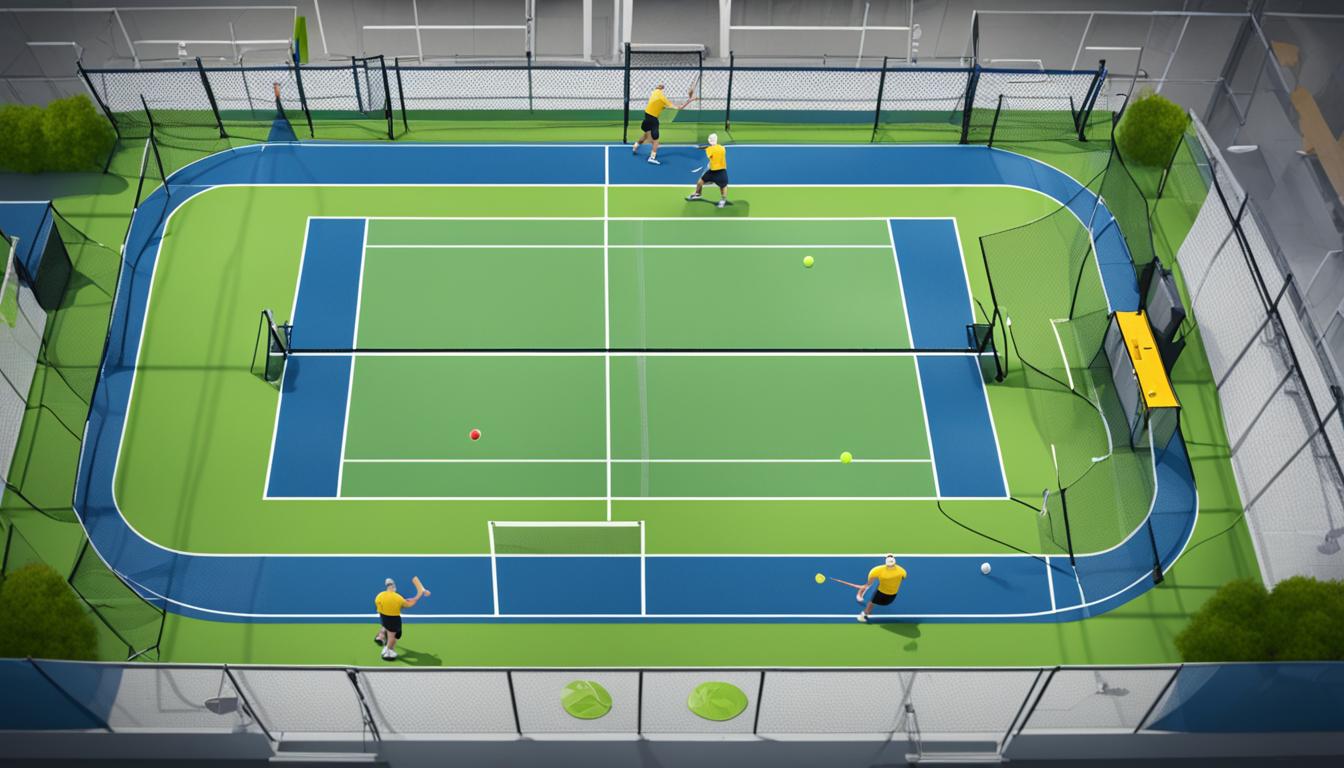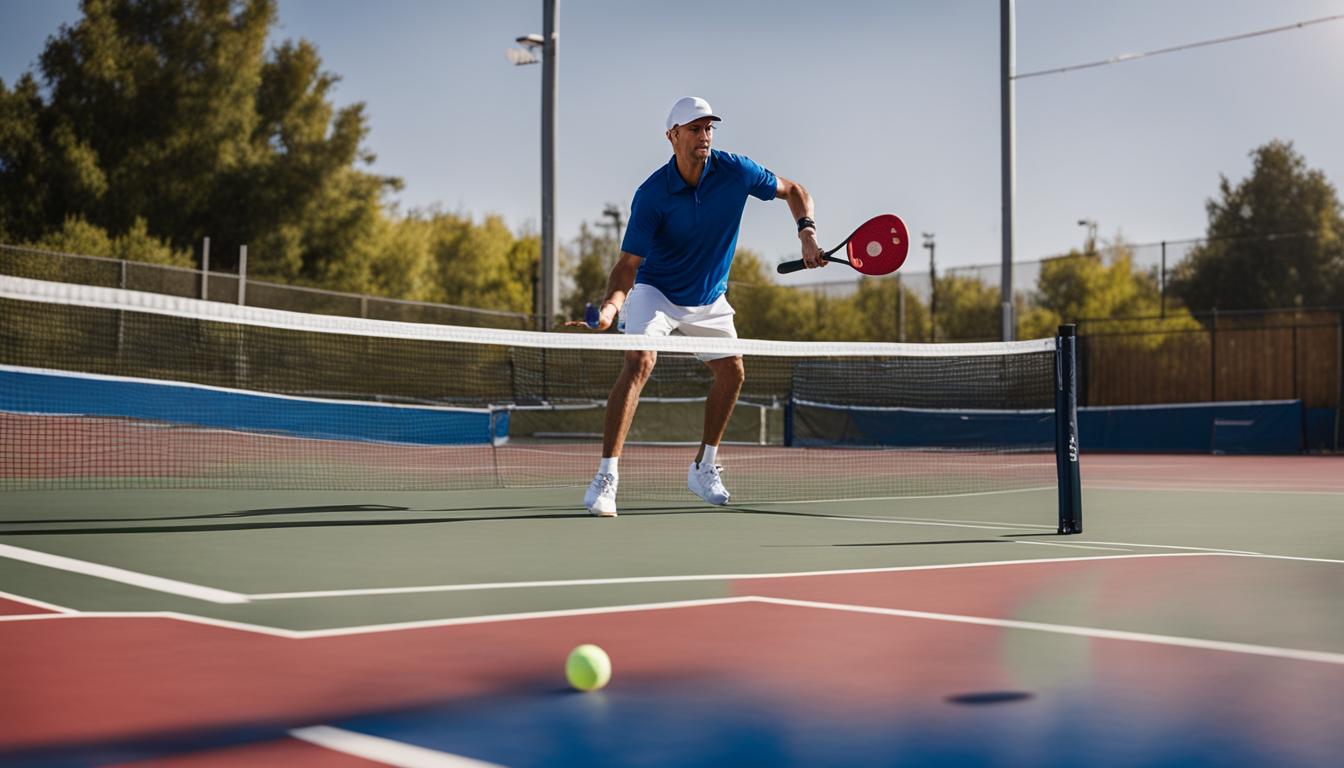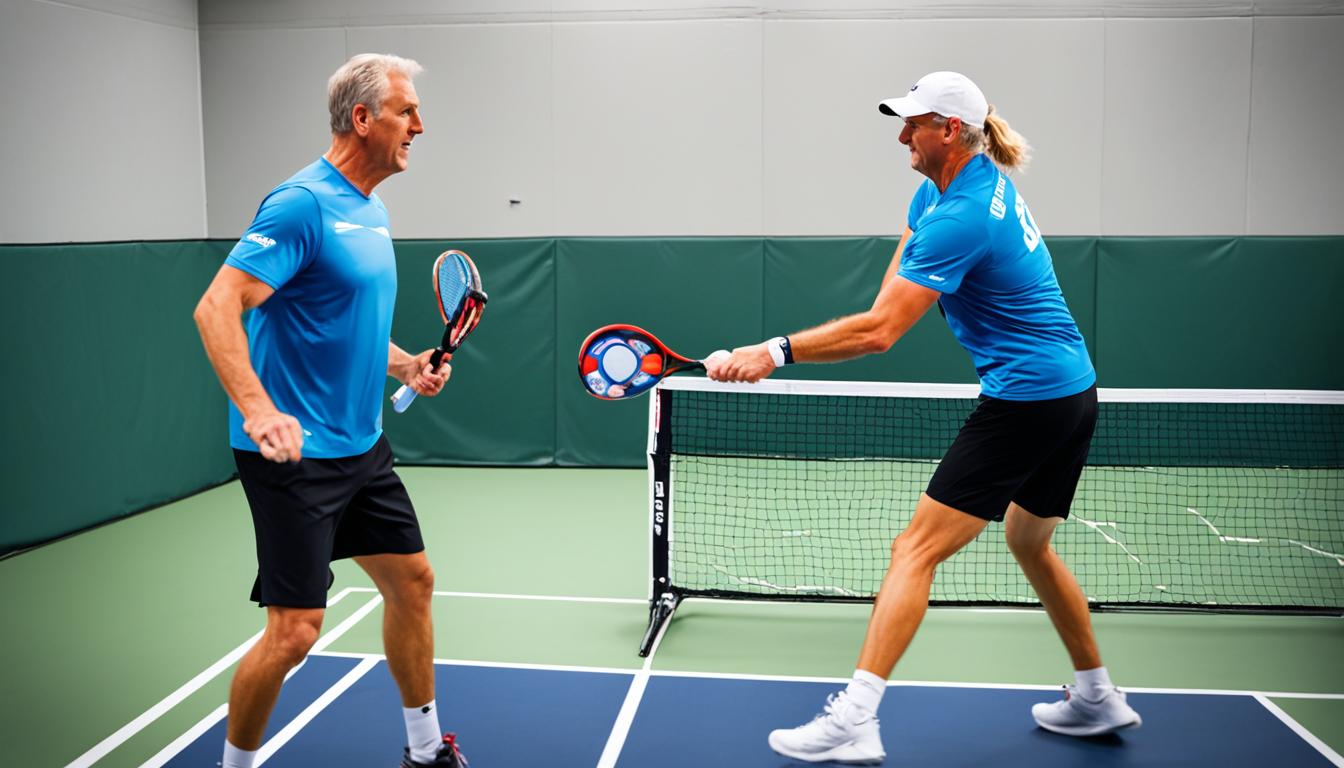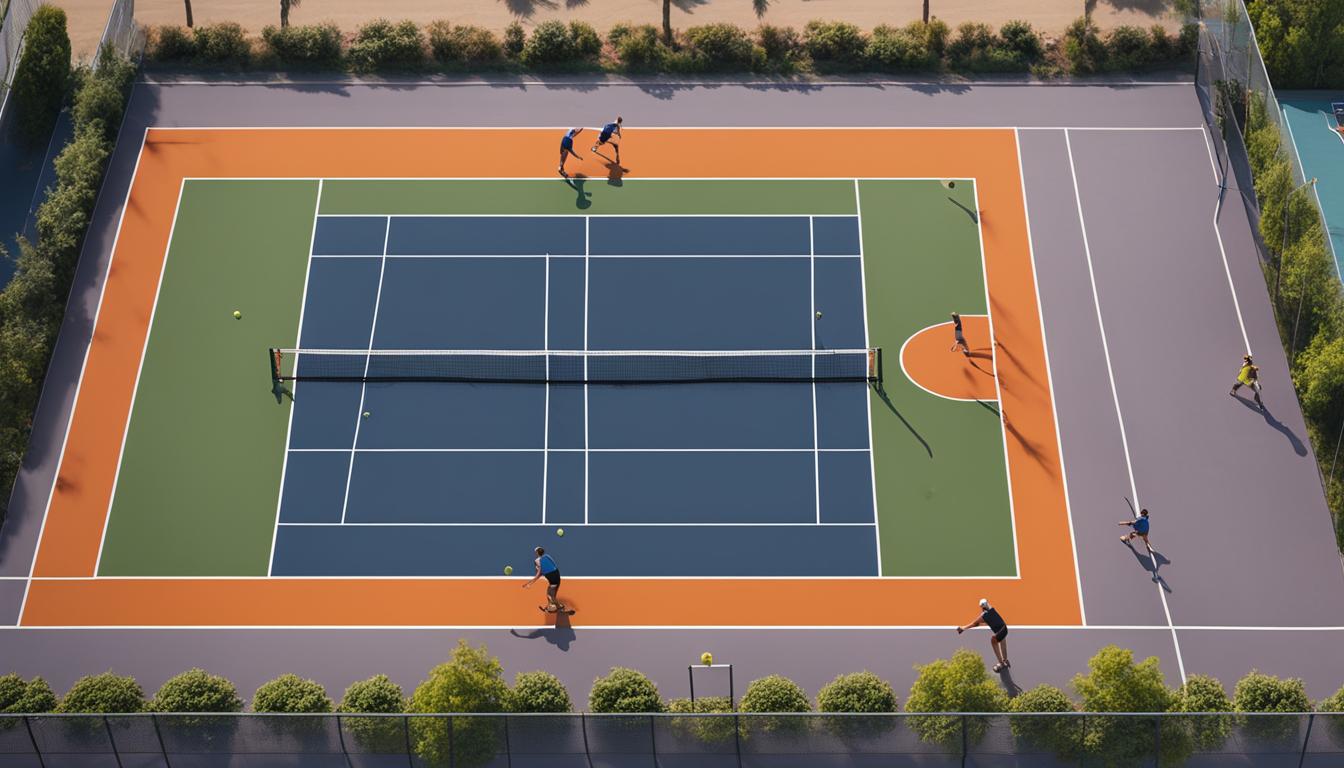Can You Enter the Kitchen
After Hitting the Ball in Pickleball?
Pickleball kitchen rules? Have you ever found yourself engaged in a thrilling game of pickleball, trying to strategically outmaneuver your opponents on the court? As you position yourself near the net, you prepare for a powerful shot, hoping to gain the upper hand. But then a question arises in your mind: can you enter the kitchen after hitting the ball in pickleball?
The kitchen in pickleball refers to the non-volley zone, a seven-foot area on each side of the net. This area plays a crucial role in the game, determining where players can and cannot make certain shots. It serves as a boundary, creating a fair and balanced playing field.
Imagine this scenario: you hit a perfectly timed shot, sending the ball soaring over the net. But as you make contact with the ball, your momentum carries you forward. The question remains: can you step in the kitchen in pickleball after hitting the ball?
The answer is both simple and precise. Yes, you can step in the kitchen in pickleball, as long as you do not volley the ball. This means you can enter the kitchen before the ball bounces, but you must ensure that both of your feet are outside the kitchen before hitting a volley shot. Stepping into the kitchen after hitting the ball is a violation of the kitchen rule.
Understanding the kitchen rules in pickleball is essential to avoid penalties and maintain fair play. So, let’s dive deeper into the specifics of the kitchen rule and explore how it shapes the game of pickleball.
Rules About the Kitchen in Pickleball:
- The kitchen in pickleball refers to the non-volley zone, a seven-foot area on each side of the net.
- Players are allowed to enter the kitchen as long as they do not volley the ball.
- Stepping into the kitchen after hitting the ball is a violation of the kitchen rule.
- Understanding the kitchen rule is essential for fair play and strategic gameplay.
- Stay tuned to explore more pickleball rules and strategies!
Understanding Pickleball Kitchen Rules
When playing pickleball, it’s essential to understand the rules of the kitchen, also known as the non-volley zone. This area plays a critical role in the game’s strategy and fair play. To avoid violations and ensure an enjoyable playing experience, familiarize yourself with the pickleball court rules and game rules, including the kitchen rule.
The kitchen rule in pickleball states that players should not volley the ball while standing within the boundaries of the non-volley zone. This rule prevents players from dominating the game with powerful shots near the net. Violating the kitchen rule can result in a fault, leading to a point loss or loss of serve.
Knowing and abiding by the kitchen rule is crucial for maintaining a fair game. By understanding the pickleball rules and specifically the kitchen rule, players can make informed decisions during gameplay and avoid unnecessary errors. Whether you’re new to the sport or a seasoned player, the kitchen rule remains a fundamental aspect of pickleball that should not be overlooked.
To further clarify the kitchen rule and its implications, let’s take a closer look at some specific aspects:
What is the kitchen in pickleball?
The kitchen in pickleball refers to the non-volley zone, which is a seven-foot area on each side of the net. This zone extends from sideline to sideline, creating a designated area where players must exercise caution before hitting volleys. It’s crucial to understand that the kitchen is off-limits for volleys and serves as a buffer zone to ensure fair play.
Can you step in the kitchen in pickleball?
Yes, you can step into the kitchen in pickleball as long as you do not violate the kitchen rule. Stepping into the kitchen before the ball bounces is permissible. However, you must ensure that both your feet are outside the kitchen boundaries before hitting a volley shot. It’s important to remember that stepping into the kitchen after hitting the ball is a violation of the kitchen rule.
Can you ever hit the ball from the kitchen in pickleball?
No, hitting the ball from the kitchen in pickleball is considered a violation of the kitchen rule. Players are not allowed to volley the ball within the boundaries of the kitchen. To maintain fair play, shot sequences that involve hitting the ball from the kitchen should be avoided.
What area can you not enter in pickleball?
The area you cannot enter in pickleball is the kitchen, also known as the non-volley zone. Players should not step into this area during shot sequences unless both feet are outside the boundaries. An infraction of this rule is considered a kitchen violation and may result in a fault.
By understanding and adhering to the kitchen rule in pickleball, players can enjoy a competitive and fair game. The kitchen adds an extra layer of strategy to the sport and encourages skillful shot placement rather than relying solely on powerful hits near the net.
What is the Kitchen in Pickleball?
The kitchen, also known as the non-volley zone (NVZ), is a crucial area in pickleball that players need to be familiar with. It is a seven-foot area on either side of the net, extending from sideline to sideline. The kitchen rule prohibits players from volleying the ball while any part of their body is touching the kitchen. This rule ensures fair play and prevents players from dominating the game with powerful shots near the net.
If you step into the kitchen and make contact with the ball, it will be considered a fault. This means that you will lose the point or lose your serve, depending on the specific circumstances. To avoid violations of the kitchen rule, it’s important to understand the dimensions of the pickleball court and the game rules.
| Pickleball Court Dimensions | Pickleball Game Rules |
|---|---|
| The court is divided into two halves by a net, similar to a tennis court. Each half is 20 feet wide and 44 feet long. | The game begins with a serve, which must be made diagonally to the opponent’s half of the court. The ball must clear the kitchen and land within the boundaries of the opponent’s court. |
| The kitchen is a seven-foot area on either side of the net, from sideline to sideline. Players are not allowed to volley the ball while any part of their body is touching the kitchen. | Players must let the ball bounce once on their side before they can hit it in the air. This is known as the double bounce rule and ensures that both teams have an equal opportunity to return the shot. |
Understanding the dimensions of the pickleball court and the game rules is essential for playing the game correctly and avoiding violations of the kitchen rule. By respecting the kitchen boundaries and following the rules, you can enjoy a fair and competitive game of pickleball.

Can You Step in the Kitchen in Pickleball?
When it comes to the kitchen in pickleball, there are specific rules and restrictions that players must follow. The kitchen, also known as the non-volley zone, plays a crucial role in maintaining fair play and strategic gameplay. But can you step in the kitchen in pickleball? Let’s find out.
Yes, you can step in the kitchen in pickleball, but there are certain conditions that you need to be aware of. The key rule to remember is that you cannot volley the ball while standing in the kitchen. This means you can enter the kitchen before the ball bounces, but you must ensure that both of your feet are outside of the kitchen before hitting a volley shot.
Stepping into the kitchen after hitting the ball is considered a violation of the kitchen rule. It’s essential to understand and respect this rule to maintain fair play and prevent any unfair advantages during the game.
Entering the Kitchen Before the Ball Bounces
One common question that players have is whether they can step in the kitchen before the ball bounces. The answer is yes, you can enter the kitchen before the ball bounces, as long as you do not violate the kitchen rule by volleying the ball from within the kitchen.
Entering the kitchen before the ball bounces allows players to position themselves strategically for the next shot. However, it’s crucial to remember that both of your feet must be outside of the kitchen when you hit a volley shot.
Understanding the Kitchen Violation
Violating the kitchen rule can result in a fault, which can lead to a point loss or a loss of serve. It’s important to avoid entering the kitchen after hitting the ball, as this is considered a violation. By staying outside of the kitchen while volleying the ball, you ensure fair play and keep the game competitive for both teams.
It’s worth noting that different variations of the kitchen rule may exist, depending on the type of pickleball game being played. However, the general principle of not volleying the ball from within the kitchen remains consistent across variations.
Now that you know whether you can step in the kitchen in pickleball let’s explore other aspects of this rule, such as when you can enter the kitchen and what areas you should avoid entering.
| Can You Step in the Kitchen? | Condition |
|---|---|
| Yes | As long as you do not violate the kitchen rule by volleying the ball from within the kitchen. |
Can You Ever Hit the Ball from the Kitchen in Pickleball?
No, you are not allowed to hit the ball from the kitchen in pickleball. The kitchen rule, also known as the non-volley zone rule, prohibits players from volleying the ball within the boundaries of the kitchen. This rule ensures fair play and prevents players from dominating the game near the net.
The kitchen, which is a seven-foot area on each side of the net, is specifically designed to eliminate powerful smashes and promote strategy. Players can enter the kitchen, as long as they do not hit the ball while standing in it. This means you can step into the kitchen before the ball bounces, but you must quickly move your feet back out to avoid violating the kitchen rule.
If a player hits the ball from the kitchen, it is considered a kitchen violation and results in a fault. This means the opposing team will be awarded a point or regain the serve, depending on the stage of the game. To play pickleball successfully, it is important to understand and abide by the kitchen rule.

Remember, the kitchen rule is in place to maintain fairness and ensure that no player gains an unfair advantage near the net. By respecting the kitchen boundaries and developing strategies that utilize shots outside the kitchen, you can excel in the game of pickleball and enjoy a competitive and engaging experience.
What Can You Not Do in the Kitchen in Pickleball?
When playing pickleball, there are several rules and restrictions surrounding the kitchen, also known as the non-volley zone. The purpose of these rules is to ensure fair play and prevent players from gaining an unfair advantage near the net.
- You cannot volley the ball while standing in the kitchen. This means that when the ball is in the air, you must make sure that no part of your body is touching the kitchen when hitting the ball.
- You cannot have any part of your body or equipment touch the kitchen while making a shot. This includes leaning, touching, or stepping on any part of the kitchen area.
- A serve cannot land in the kitchen. When serving, the ball must clear the kitchen, either by landing in the opposing court or beyond the kitchen boundary.
Violating any of these rules is considered a kitchen violation and results in a fault. A fault can lead to a loss of point or serve, depending on the specific circumstances of the violation.
By adhering to these kitchen rules, players can ensure a level playing field and maintain the integrity of the game. It adds a strategic element to the sport, requiring players to think strategically and carefully execute their shots within the boundaries of the court.
Remember, the kitchen is an integral part of pickleball, and understanding and respecting the rules associated with it is essential for an enjoyable and fair game.
Kitchen Violations and Consequences
| Violation | Consequence |
|---|---|
| Volleying the ball while standing in the kitchen | Results in a fault, loss of point, or loss of serve |
| Having any part of the body or equipment touch the kitchen while making a shot | Results in a fault, loss of point, or loss of serve |
| Serve landing in the kitchen | Results in a fault, loss of point, or loss of serve |
When Can You Enter the Kitchen in Pickleball?
In the fast-paced game of pickleball, understanding the rules surrounding the kitchen is essential to your success on the court. So, when exactly can you enter the kitchen in pickleball? Let’s dive into the details.
The kitchen in pickleball, also known as the non-volley zone, is a vital area on each side of the net that measures seven feet in depth. It is designed to prevent players from executing volleys too close to the net, ensuring fair play and strategic gameplay.
You are allowed to enter the kitchen in pickleball at any point during the game, as long as you do not violate the kitchen rule by volleying the ball. This means you can step into the kitchen as long as you refrain from hitting the ball before it bounces. However, it’s important to note that while you are in the kitchen, you must ensure that both of your feet are outside the boundaries of the kitchen before attempting a volley shot.
It’s also worth mentioning that you can be in the kitchen while your partner volleys outside of the kitchen. This teamwork strategy allows you to maximize your position on the court and maintain control of the game.
However, there is one exception when it comes to being in the kitchen: you cannot be in the kitchen during the act of volleying the ball. Violating this rule will result in a fault and could potentially cost you valuable points.
Now that you know when you can enter the kitchen in pickleball, it’s time to put your knowledge into practice on the court. Remember to play strategically, respect the kitchen boundaries, and enjoy the game to the fullest!
Strategies for Playing in the Kitchen in Pickleball
Playing in the kitchen in pickleball requires strategic thinking and precise shots. To make the most of your time in this crucial area of the court, consider these effective strategies:
1. Utilize Dinks
A dink is a soft shot aimed at forcing your opponent into a tight vertical angle. By executing a controlled and accurate dink, you can create a challenging situation for your opponent, making it difficult for them to return the ball effectively. Dinks are an excellent way to maintain control from the kitchen and keep your opponent on their toes.
2. Master the Erne Shot
The erne shot is a more advanced technique that involves jumping or running around the kitchen to hit a fast-paced return. By using the erne shot, you can catch your opponent off guard and create opportunities for quick putaways. However, it is essential to practice this shot and time it correctly to avoid violations.
3. Practice Precision and Placement
When playing in the kitchen, precision and placement are of utmost importance. Aim to hit shots close to the sideline or to the corners, making it challenging for your opponent to return the ball effectively. By strategically placing your shots, you can control the pace of the game and set yourself up for success.
4. Stay Within the Boundaries
While playing in the kitchen, it is crucial to adhere to the rules and stay within the boundaries. Avoid stepping or touching the kitchen line to prevent violations. Remember, violating the kitchen rule can result in a fault and a loss of the point.
5. Communicate and Coordinate with Your Partner
In doubles pickleball, effective communication and coordination with your partner are key to success. Discuss strategies, coordinate movements, and anticipate each other’s shots to maintain control of the kitchen area. Work together as a team to dominate the game and capitalize on your opponents’ weaknesses.
By implementing these strategies, you can enhance your performance in the kitchen and gain a competitive edge in the game of pickleball.

| Strategies for Playing in the Kitchen in Pickleball |
|---|
| Utilize Dinks |
| Master the Erne Shot |
| Practice Precision and Placement |
| Stay Within the Boundaries |
| Communicate and Coordinate with Your Partner |
Understanding the History of the Kitchen in Pickleball
The term “kitchen” in pickleball likely originated from the shuffleboard game, where a similar area called the kitchen is a no-go zone. The creators of pickleball may have borrowed the term to designate the non-volley zone in the game. The kitchen has become an integral part of pickleball, adding an element of finesse and strategy to the sport.
The term “kitchen” in pickleball likely originated from the shuffleboard game, where a similar area called the kitchen is a no-go zone. The creators of pickleball may have borrowed the term to designate the non-volley zone in the game. The kitchen has become an integral part of pickleball, adding an element of finesse and strategy to the sport.
Conclusion
The kitchen rule is a fundamental aspect of pickleball that ensures fair play and strategic gameplay. By understanding the rules and regulations of the kitchen, players can avoid faults and maintain the integrity of the game. It is important to remember that you can enter the kitchen in pickleball, as long as you do not violate the rule by hitting the ball while standing in the kitchen.
When playing pickleball, the kitchen refers to the non-volley zone, a seven-foot area on each side of the net. Players are not allowed to volley the ball while any part of their body is touching the kitchen. This rule prevents players from dominating the game with powerful shots near the net, creating a more balanced and competitive playing field.
To play within the kitchen regulations, make sure you step in the kitchen only after hitting the ball and ensure that both feet are outside the kitchen before hitting a volley shot. Hitting the ball from the kitchen is a violation of the rule and will result in a fault. By following these guidelines, you can navigate the kitchen effectively and implement strategic shots to outplay your opponents.
In summary, the kitchen rule in pickleball is an integral part of the game that promotes fairness and strategic gameplay. By understanding the regulations, players can enjoy a balanced and competitive pickleball experience while avoiding faults. So, step into the court, play by the rules, and master the art of hitting the ball in pickleball!

